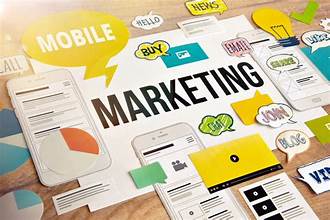
What is Mobile Marketing?
Definition
Mobile marketing encompasses various methods for promoting products or services through mobile devices. It includes advertising, push notifications, SMS marketing, in-app promotions, and mobile-optimized websites, aiming to deliver personalized, location-based, and real-time content to users on their mobile devices.
Objectives
-
- Enhance User Engagement: Reach users where they spend a significant amount of time.
-
- Drive Conversions: Increase sales, app downloads, or lead generation through targeted mobile campaigns.
-
- Improve Customer Experience: Provide seamless and convenient interactions tailored to mobile users.
-
- Build Brand Awareness: Increase visibility and recognition through mobile channels.
Key Components of Mobile Marketing
1. Mobile-Optimized Websites
Websites designed to offer a seamless user experience on mobile devices.
-
- Responsive Design: Adapts the layout to fit different screen sizes.
-
- Fast Loading: Optimizes content to load quickly on mobile networks.
-
- User-Friendly Navigation: Simplifies navigation with easy-to-use menus and buttons.
2. Mobile Apps
Standalone applications that provide enhanced functionalities and personalized experiences.
-
- Utility: Offer value through features like shopping, booking, or content consumption.
-
- Engagement: Utilize push notifications and in-app messaging to engage users.
-
- Monetization: Implement in-app purchases, ads, or subscriptions.
3. SMS and MMS Marketing
Text messaging strategies for direct communication with users.
-
- SMS Marketing: Send promotional messages, alerts, or reminders.
-
- MMS Marketing: Include multimedia content like images, videos, or audio in messages.
4. Mobile Advertising
Advertisements specifically tailored for mobile devices.
-
- Types: Banner ads, video ads, native ads, interstitial ads.
-
- Platforms: Social media (e.g., Instagram, TikTok), search engines, mobile apps.
5. Push Notifications
Short, clickable messages sent to users who have installed your mobile app.
-
- Usage: Announce updates, promotions, or personalized messages.
-
- Segmentation: Target notifications based on user behavior and preferences.
6. Location-Based Marketing
Strategies that use the geographic location of mobile users to deliver relevant messages.
-
- Geofencing: Trigger messages when users enter or exit a defined geographic area.
-
- Beacons: Use Bluetooth technology to send targeted messages within close proximity.
7. QR Codes
Scannable codes that link to digital content or actions.
-
- Usage: Direct users to websites, app downloads, or special promotions.
-
- Integration: Place QR codes on physical products, in-store displays, or printed materials.
Benefits of Mobile Marketing
-
- Widespread Reach: Connect with a broad audience as mobile device usage continues to grow.
-
- Personalization: Deliver targeted content based on user preferences, behavior, and location.
-
- Real-Time Engagement: Communicate instantly with users, providing timely information and updates.
-
- Cost-Effectiveness: Often more affordable than traditional marketing methods, with the potential for high ROI.
-
- Enhanced User Experience: Offer a more convenient and engaging experience tailored to mobile users.
Mobile Marketing Strategies
**1. Mobile-Friendly Content
-
- Creation: Develop content optimized for mobile consumption, such as short articles, videos, and infographics.
-
- Optimization: Ensure fast loading times and readability on smaller screens.
**2. App Development
-
- Design: Create apps that provide value through features, ease of use, and performance.
-
- Promotion: Use app store optimization (ASO) and mobile ads to drive downloads.
**3. Personalization
-
- Data Utilization: Leverage user data to tailor messages and offers.
-
- Behavioral Targeting: Use insights from user interactions to customize content and recommendations.
**4. Interactive Ads
-
- Formats: Utilize rich media ads, playable ads, and interactive video ads.
-
- Engagement: Encourage user interaction to increase ad effectiveness.
**5. Omnichannel Integration
-
- Consistency: Ensure a seamless experience across mobile, desktop, and in-store interactions.
-
- Coordination: Integrate mobile campaigns with other marketing channels for cohesive messaging.
**6. Location-Based Campaigns
-
- Geo-targeting: Send location-specific offers and messages to nearby users.
-
- Local SEO: Optimize for local search results to attract mobile users looking for nearby services or products.
**7. Push Notification Strategy
-
- Frequency: Balance the frequency of notifications to avoid overwhelming users.
-
- Relevance: Send personalized and relevant notifications based on user behavior and preferences.
Mobile Marketing Tools
-
- Google Ads: Run mobile search and display ads targeting specific audiences.
-
- Facebook Ads: Use Facebook’s mobile ad formats to reach users on their mobile devices.
-
- Braze: Engage users with personalized push notifications, in-app messages, and emails.
-
- AppsFlyer: Measure and optimize mobile app marketing campaigns.
-
- Leanplum: Automate personalized mobile messaging and push notifications.
-
- MoEngage: Provide multi-channel engagement for mobile apps, including in-app messages and email.
-
- QR Code Generator: Create QR codes for various purposes, such as linking to websites or app downloads.
Best Practices for Mobile Marketing
-
- Focus on User Experience
-
- Design mobile content and apps with a user-first approach, prioritizing ease of use and accessibility.
-
- Focus on User Experience
-
- Optimize for Mobile Search
-
- Ensure your website and content are optimized for mobile SEO to improve visibility in mobile search results.
-
- Optimize for Mobile Search
-
- Leverage Data for Personalization
-
- Use data analytics to understand user behavior and preferences, allowing for more targeted and personalized marketing efforts.
-
- Leverage Data for Personalization
-
- Implement Responsive Design
-
- Ensure your website and emails are responsive, adapting to different screen sizes and orientations.
-
- Implement Responsive Design
-
- Use Clear Calls-to-Action
-
- Include prominent and clear calls-to-action in mobile ads, content, and notifications to guide user behavior.
-
- Use Clear Calls-to-Action
-
- Test and Iterate
-
- Regularly test different mobile marketing tactics and optimize based on performance data.
-
- Test and Iterate
-
- Prioritize Privacy
-
- Respect user privacy and adhere to regulations regarding data collection and usage, such as GDPR or CCPA.
-
- Prioritize Privacy
-
- Integrate with Other Channels
-
- Coordinate mobile marketing efforts with other digital and offline channels to create a unified brand experience.
-
- Integrate with Other Channels
Example of Mobile Marketing in Action
Scenario: A retail brand wants to drive more traffic to its physical stores through a mobile marketing campaign.
Steps:
-
- App Development: Create a mobile app offering exclusive discounts and loyalty rewards.
-
- Push Notifications: Send notifications about in-store promotions and flash sales to app users based on their location.
-
- Geofencing: Implement geofencing around store locations to trigger special offers when users are nearby.
-
- Mobile Ads: Run targeted mobile ads on social media and Google Ads to promote the app and in-store events.
-
- QR Codes: Place QR codes in-store and in marketing materials to encourage app downloads and engagement.
-
- Omnichannel Integration: Integrate mobile promotions with email campaigns and social media posts for a consistent message.
Results: Increased foot traffic to stores, higher app engagement, and improved customer retention through personalized rewards and offers.


kJEFCVc YLaJo SBeFtr
I am extremely impressed together with your writing skills and
also with the format for your blog. Is that this a paid subject matter or did you modify it your self?
Anyway keep up the nice quality writing, it’s rare to look a nice blog like
this one these days. Blaze ai!